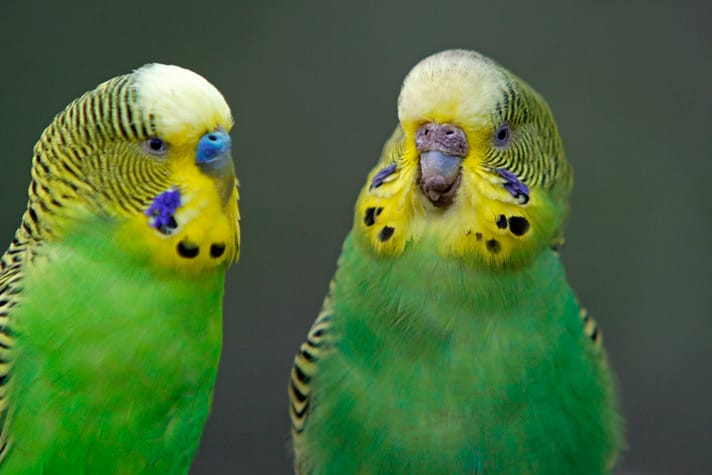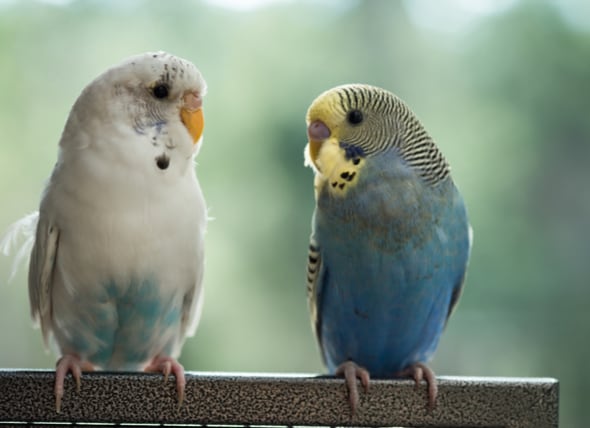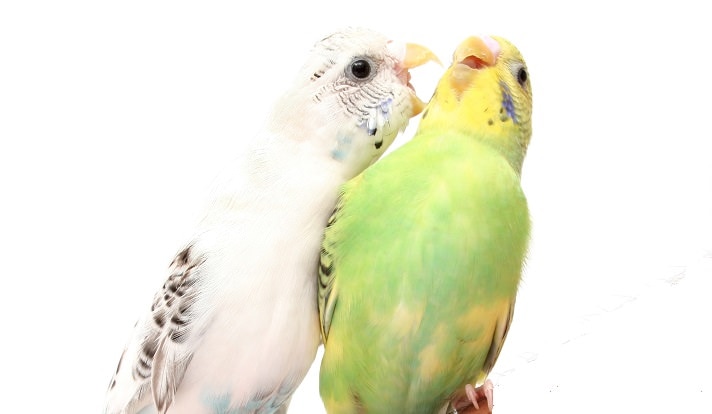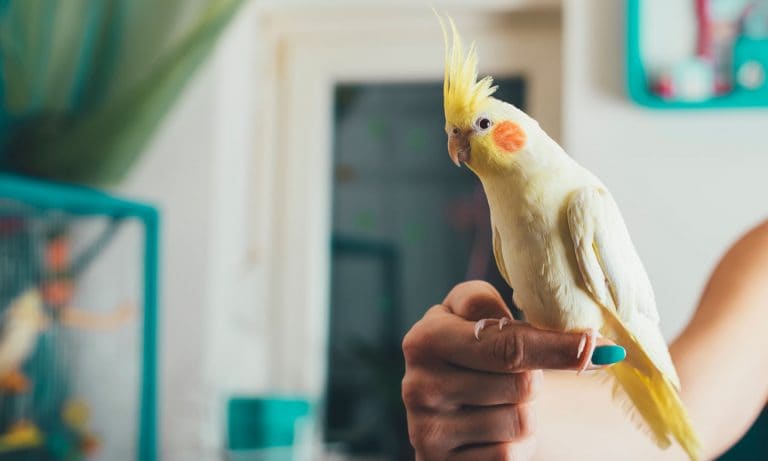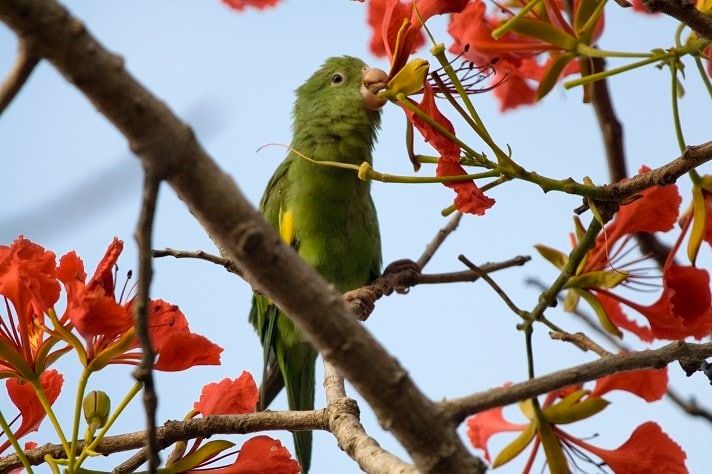The shell parakeet (Melopsittacus undulatus), named for the shell-like wavy undulations on its wings, is better known in America as the pet parakeet or the Australian budgerigar or budgie. As one of the most popular, colorful and easy breeders of the entire parrot family, its whimsical personality has endeared it to the hearts of millions with its natural charm, cheerful chatter and kaleidoscopic tints, tones and pigments.
This fascinating little Australian bird, ranging from 6 to 8 inches in size, caters to various tastes and preferences. Whether you prefer the smaller, less extravagant American pet size, or the loftier, larger exhibition show bird, such as the English budgie — or even a cross between the two — the choices and colors are endless. Budgies can thrive in individual households and bird aviaries, provided their needs are met.
The DNA sequences of this hearty little parakeet reveal its closest relatives to be the lories (subfamily Loriinae) and the fig parrots (tribe Cyclopsittacini). As energetic as its close relatives, budgies require a lot of exercise in order to flourish. Budgies delve straight into your heart, if not directly into mischief — especially so if not carefully supervised.
Pet Parakeets
When considering adding a budgie to your household, base your decision on whether you can provide a safe, healthy and interactive environment.
Ideally, try to get a young budgie between 38 and 42 days of age, provided it is fully weaned and eating on its own without its parents’ help. You might more easily adopt young parakeets directly from a breeder who keeps track of their ages by closed banding with traceable, aluminum, seamless leg bands from a national organization. Some retail stores buy young parakeets or “bar-heads” direct from local breeders. Bar-head is the nickname given to young budgies under 3 months of age, in normal colored varieties, because of the black lines running across the forehead. Another method to identify a young parakeet is by a blackish tip that may be seen at the end of the beak that will disappear by the juvenile molt.
Unless handled every day, the younger the budgie you are able to get, the easier taming and training will be. Ideally, a 6-week-old budgie is much easier to tame than a 10 week old.
Keeping A Pair Of Budgies/Parakeets
Getting two budgies or adding another bird is a smart move if you are at work all day, or away a lot and cannot interact with your budgie as much as you used to. Female parakeets are dominant in their social interactions, so base your selection of a second budgie on gender. If you own a male and its cage is small, your best option is to select another male. Male budgies get along well together; they serenade one another, and usually interact harmoniously.
If the cage is larger, you could consider selecting a female budgie for your male, provided the male budgie has space in which to escape, should the female reject his constant courtship advances when hormone levels rise.
Because females are more prone to territorial fighting over space, it is less advisable to keep two females together. Female parakeets bicker more among themselves, stand their own ground, and their disruptive arguing leads to squawking beak duels that disrupts everyone.
If females are kept together in a larger flight cage, confrontations are less likely to occur than in a smaller cage. However, a female kept with a male will usually result in the male flying off to escape the female? wrath from his constant attention when hormone levels rise. A male and female budgie pair may breed and have chicks, so carefully consider keeping an opposite-sex pair.
One disadvantage to consider when keeping a pair of budgies is that they may devote more attention to one another and become less dependent upon you for companionship. You can easily avoid this if you train your first budgie before getting and training another.
Once you get your new budgie, keep it separate in its own cage during quarantine, when you can work on training your new bird. When you finally introduce your birds to one another, place them in neutral territory — such as a playstand — and allow them to eventually select the cage of their choice. This method will allow both parakeets to remain tame, and interact with you, as well as with one another.
Introducing New Budgies/Parakeets
Never place one budgie into another budgie cage or with a pair of budgies, even if the birds appear to be getting along outside the cage. This would be like placing a stranger in your bedroom without your consent. Keep the cages side-by-side and allow socialization to take place in a neutral territory. Your budgies will eventually select the dwelling they prefer, usually by preliminary visits to one another’s cages. This safer introduction to living arrangements will help reduce the possibility of quarreling and bickering.
When you introduce a new bird into a flight with other birds, watch the reaction of the flock. The newcomer will immediately be tested and confronted by other birds to learn where it fits into the social hierarchy. Its social standing will determine where it is allowed to perch, and in what order it is able to eat, play with toys or find a mate.
Housing And Food For Parakeets
Obtain the largest bird cage you can afford to provide as much space as possible for your budgie(s) to move around. Because budgies fly back and forth, more than up and down, select a cage with more length than height. The cage should be constructed with 1/4-inch bar spacing to make it easier for your budgie to climb around and keep it from getting stuck in the bars. Avoid bamboo cages or any material your budgie could chew through to escape.
Have a minimum of two parrot bird food cups, and a water dish or bottle, filled daily and kept clean. Clean the cage substrate daily if possible — use dry newspaper, plain paper towels, cage liners or other nontoxic substrates.
Provide at least two safe bird toys, made specifically for budgies to enrich their environment so they can amuse themselves. Budgies dearly love mirrors, especially males who will serenade their image and enthusiastically tap their beaks to their reflection for hours of enjoyment.
Budgie Health
Budgies require daily exercise to build muscle, trim fat and stay healthy; they are prone to putting on weight, especially young females, and can develop fatty livers and tumors that could shorten their lifespan to just a few short years. Provide daily exercise outside the cage in a location that is “budgie-proofed” — lacking open doors and windows, mirrors they may crash into or other high-risk areas such as the kitchen with hot stoves, open pots and other dangers.
Provide a quality parrot bird food that includes budgie-size pellets and/or a quality parakeet bird food with plenty of dark green leafy vegetables, legumes and grains, orange/red/yellow vegetables, seasonal fruit and fresh, clean drinking water each day. Offer millet spray and other treats occasionally and always keep a fresh, clean cuttlebone. The combination of healthy foods and plenty of exercise will give your budgie the potential to live as long as 10 to 15 years or even more.
Because budgies catch cold easily, any location you choose should be completely free of either hot or cold drafts, so avoid nearby heaters or air conditioners. Test the air to check for any sign of a breeze. Comfortable room temperature is ideal although temperatures above or below 68 to 72 degrees are acceptable provided budgies are gradually acclimated and the temperature remains constant without continuous fluctuations.
Excerpt from BIRD TALK Magazine, August 2010 issue, with permission from its publisher, Lumina Media.
Share:
